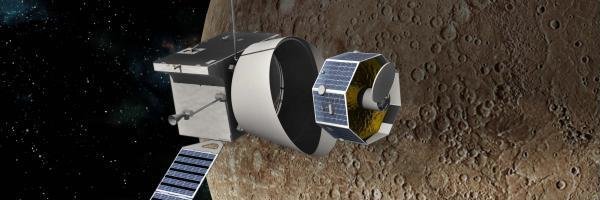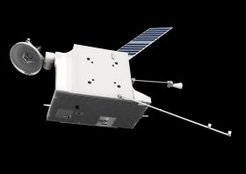
BepiColombo: Mission to planet Mercury
The BepiColombo Mission to planet Mercury is a joint project between the European Space Agency ESA and the Japanese counterpart JAXA, launched in October 2018 and orbiting Mercury from end of 2026 onwards. The project named after Guiseppe (Bepi) Colombo consists of two spacecraft:
- the Mercury Planetary Orbiter (MPO) provided by ESA and
- the Mercury Magnetospheric Orbiter (MIO) provided by JAXA
providing for the first time two-point measurements in the vicinity of the closest planet in our solar system.
The first scientific measurements with the instruments on board Bepi Colombo were successfully collected during the Earth flyby on 9/10 April 2020. The next measurements are planned for two Venus flyby on 15 October 2020 and 11 August 2021.
MMO:

Total mass: 275 kg
Payload mass: 45 kg
Science objectives
(from ESA website)
- Origin and evolution of a planet close to the parent star
- Mercury as a planet: form, interior, structure, geology, composition and craters
- Mercury's vestigial atmosphere (exosphere): composition and dynamics
- Mercury's magnetized envelope (magnetosphere): structure and dynamics
- Origin of Mercury's magnetic field
- Test of Einstein's theory of general relativity
The scientific objectives behind BepiColombo can be viewed by
considering the following 11 questions:

Total mass: 1150 kg
Payload mass: 80 kg
- What can we learn from Mercury about the composition of the solar nebula and the formation of the planetary system?
- Why is Mercury's normalized density markedly higher than that of all other terrestrial planets, Moon included?
- Is the core of Mercury liquid or solid?
- Is Mercury tectonically active today?
- Why such a small planet does possess an intrinsic magnetic field, while Venus, Mars and the Moon do not have any?
- Why do spectroscopic observations not reveal the presence of any iron, while this element is supposedly the major constituent of Mercury?
- Do the permanently shadowed craters of the polar regions contain sulphur or water ice?
- What are the production mechanisms of the exosphere?
- In the absence of any ionosphere, how does the magnetic field interact with the solar wind?
- Is Mercury's magnetised environment characterised by features reminiscent of the aurorae, radiation belts and magnetospheric substorms observed at Earth?
- Since the advance of Mercury's perihelion was explained in terms of space-time curvature, can we take advantage of the proximity of the Sun to test general relativity with improved accuracy?
Mission Facts
Launch Date: 2018
Arrival Date: 2026
Mission End: Nominally 1 year in Mercury orbit
Launch Vehicle: Ariane 5
Launch Mass: 4100 kg
Cruise: Heliocentric transfer orbit
At Mercury: MPO polar orbit 400 × 1500 km, 2.3 hr period
MIO polar orbit 400 × 12 000 km, 9.3 hr period
BepiColombo MPO
http://sci.esa.int/science-e/www/area/index.cfm?fareaid=30
BepiColombo MIO
http://www.stp.isas.jaxa.jp/mercury/index-e.html
Messenger
http://messenger.jhuapl.edu/ (Other Mercury mission)













